

National Geographic. Biography of Christopher Columbus for Children: Famous Explorers for Kids - FreeSchool. World History The Age of Discovery in 5 Minutes. Age of Exploration. Ferdinand Magellan - the first journey around the world - mrdowling.com. Home » Renaissance » Ferdinand Magellan Aristotle first theorized that the earth was round.
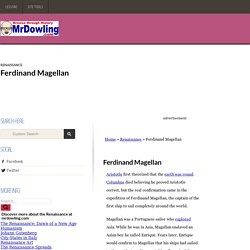
Columbus died believing he proved Aristotle correct, but the real confirmation came in the expedition of Ferdinand Magellan, the captain of the first ship to sail completely around the world. Magellan was a Portuguese sailor who explored Asia. While he was in Asia, Magellan enslaved an Asian boy he called Enrique. Years later, Enrique would confirm to Magellan that his ships had sailed to the east by traveling west. Advertisement Magellan left Spain in 1519 with five ships. The starving sailors arrived on the island of Guam after more than six months at sea, and then moved on to the Philippines. Magellan had survived eighteen months at sea, but he was killed in battle in the Philippines. One of Magellan’s five ships did make it back to Spain, only twelve days less than three years after their journey started. Resources Download this lesson as Microsoft Word file or as an Adobe Acrobat file. Mr. Christopher Columbus- Hero or Villain? Step 1: Dear Diary You will read from Columbus's journal of his voyage of 1492, available through EDSITEment from the Internet Medieval Sourcebook.
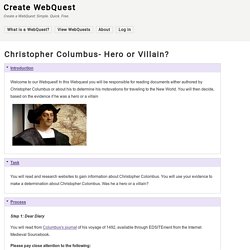
Please pay close attention to the following: The introduction—a restatement of the purpose of the voyage as explained to the King and Queen of Spain—primarily the sentence beginning, "Your Highnesses, as Catholic Christians, and princes who love and promote the holy Christian faith ... ";The entry for October 11, the day of the discovery;Excerpts from the entries for October 13, 16 and 21 for descriptions of the Native Americans Columbus encountered. Answer these quesitons using RACE about the article: What seemed of particular interest to Columbus on his voyage?
Step 2: Dear Europe. The American Story. Readings > Kirkpatrick Sale, "What Columbus Discovered" The following article, written by Kirkpatrick Sale, appeared in The Nation on October 22, 1990.
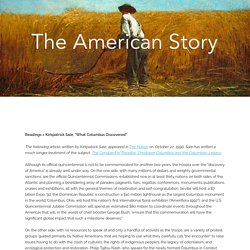
Sale has written a much longer treatment of the subject: The Conquest of Paradise: Christoper Columbus and the Columbian Legacy. Although its official quincentennial is not to be commemorated for another two years, the hoopla over the "discovery of America" is already well under way. On the one side, with many millions of dollars and weighty governmental sanctions, are the official Quincentennial Commissions, established now in at least thirty nations on both sides of the Atlantic and planning a bewildering array of parades, pageants, fairs, regattas, conferences, monuments, publications, cruises and exhibitions, all with the general themes of celebration and self-congratulation.
Just what political dimensions the quincentennial events will have, and what messages will be heard by the receiving public, remain to be seen. Outline of Objects and Topics in 1492:AN ONGOING VOYAGE Exhibit. Exhibit's IntroductionWhat Came To Be Called "America" The Caribbean: Island Societies Hammock In Fernandez de Oviedo y Valdes, La Historia general y natural de las Indias...
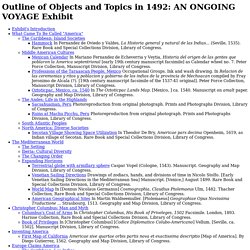
(Seville, 1535). Rare Book and Special Collections Division, Library of Congress. Middle American Cultures Mexican Calendar In Mariano Fernandez de Echeverria y Veytia, Historia del origen de las gentes que poblaron la America septentrional [early 19th century manuscript facsimile] as Calendar wheel no. 7. Peter Force Collection, Manuscript Division, Library of Congress.
Osher Map Library. The following is a literal translation from the Latin.
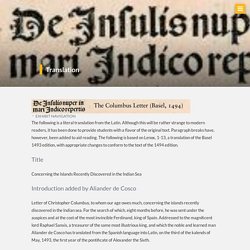
Although this will be rather strange to modern readers, it has been done to provide students with a flavor of the original text. Paragraph breaks have, however, been added to aid reading. Internet History Sourcebooks Project. This document is the from the journal of Columbus in his voyage of 1492.
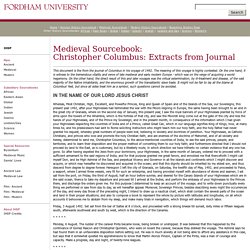
The meaning of this voyage is highly contested. On the one hand, it is witness to the tremendous vitality and verve of late medieval and early modern Europe - which was on the verge of acquiring a world hegemony. On the other hand, the direct result of this and later voyages was the virtual extermination, by ill-treatment and disease, of the vast majority of the Native inhabitants, and the enormous growth of the transatlantic slave trade.
It might not be fair to lay all the blame at Columbus' feet, but since all sides treat him as a symbol, such questions cannot be avoided. Friday, 3 August 1492. Monday, 6 August. What YOU Can Learn from The Travels of Marco Polo. Marco Polo: Facts, Biography & Travels. The story of his journey is told in "Il Milione" ("The Million"), commonly called "The Travels of Marco Polo.
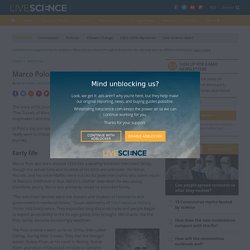
" Polo's adventures influenced European mapmakers and inspired Christopher Columbus. In Polo's day and even today, there has been some doubt about whether Polo really went to China. However, most experts agree that he did indeed make the journey. Early life Marco Polo was born around 1254 into a wealthy Venetian merchant family, though the actual date and location of his birth are unknown. Marco Polo and his travels - Who was Marco Polo? - Silk-Road.com.
One of the most well-known Europeans to travel the silk road in Medieval times was Marco Polo (1245-1324), a merchant, explorer and writer who recorded his travels in the book “Livres des merveilles du monde” (Book of the world’s marvels), published around the year 1300.
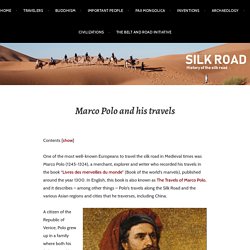
In English, this book is also known as The Travels of Marco Polo, and it describes – among other things – Polo’s travels along the Silk Road and the various Asian regions and cities that he traverses, including China. A citizen of the Republic of Venice, Polo grew up in a family where both his father Niccoló and uncle Maffeo were merchants. Even before Marco was born, the brothers had travelled extensively, setting up trading posts in Constantinople, Sudak, Crimea, and the western part of the Mongolian Empire. They even visited China.
The Black Death, 1348. The Black Death, 1348 Coming out of the East, the Black Death reached the shores of Italy in the spring of 1348 unleashing a rampage of death across Europe unprecedented in recorded history.

By the time the epidemic played itself out three years later, anywhere between 25% and 50% of Europe's population had fallen victim to the pestilence. The plague presented itself in three interrelated forms. The bubonic variant (the most common) derives its name from the swellings or buboes that appeared on a victim's neck, armpits or groin. These tumors could range in size from that of an egg to that of an apple.
The Death of Magellan, 1521. The Death of Magellan, 1521 Born in Portugal, Ferdinand Magellan took part in a number of Portuguese expeditions exploring and conquering the East Indies during the early 1500s.
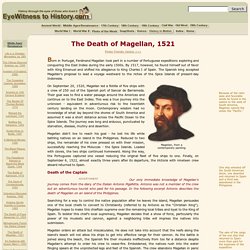
By 1517, however, he found himself out of favor with King Emanuel and shifted his allegiance to King Charles I of Spain. The Spanish king accepted Magellan's proposal to lead a voyage westward to the riches of the Spice Islands of present-day Indonesia. On September 20, 1520, Magellan led a flotilla of five ships with a crew of 250 out of the Spanish port of Sancar de Barrameda. Their goal was to find a water passage around the Americas and continue on to the East Indies. Magellan didn't live to reach his goal - he lost his life while battling natives on an island in the Philippines. The Middle Ages in 3 1/2 minutes. Inventions in the Middle Ages. Inventions in the Middle Ages - The Finer Times. From the invasion of William the Conqueror in 1066 right through to the beginning of the Tudor dynasty in 1485 a lot of wars took place during the Middle Ages, and with war comes the development of technology, weaponry, medicine and so much more.
The Middle Ages account for several centuries of human innovation and inspiration, and a vast number off innovations came from this particular historical period. The Middle Ages may have been bloody, but it led to the great changes in the way wars were fought and the tools that were used to wage battle and protect troops. During this time we know that there was disruption and change to the church, and the period saw considerable changes to ruling monarchies, leadership and ownership. Pestilence and plague created a change in medicine, farming and housekeeping, and even the peasants were able to change the way that they were perceived and treated.
Inventions Timeline: Middle Ages Innovations. Though there is a dispute as to the exact years that bookend the Middle Ages, most sources say 500 A.D. to 1450 A.D. Medieval Inventions. Until the end of the Middle Ages, all books were produced by hand - there was simply no alternative. The finest books were (literally) written by monks, and most large monasteries - including St Augustine's Abbey, Canterbury, where writing materials have been found - had scriptoria (writing rooms).
Paper was rare in England until around 1450, so books were written on scraped animal skins, called parchment or vellum, using pens made of metal or bone or quills from the feathers of a goose or swan. Manuscripts (which means 'written by hand') 'illuminated' in rich colours, like the famous Anglo-Saxon Gospels made at Lindisfarne Priory, could be very beautiful, but took years to complete; producing even ordinary books was very time consuming, and therefore very expensive.
All this changed when the printing press - using movable type of individual letters which could be arranged to form words - was invented in Germany in about 1439. Ten Medieval Inventions that Changed the World - Medievalists.net. Ten Inventions from the Middle Ages that have had lasting importance, even to the present-day. 1. Mechanical Clock Timekeeping devices have emerged since the ancient world, but it was not until the Middle Ages that the technology was invented that allowed for mechanical clocks to accurately keep track of time.
The knowledge of not only what hour it was, but even what minute and second it was, would change the way people scheduled their days and work patterns, especially in urban areas. 2. While printing technology had been developed in 11th century China, it was the 15th century German Johannes Gutenberg and his printing press that started a new era of the mass production of books. 3. Gunpowder was invented in China sometime between the 9th and 11th centuries, and it did not take long it to be used in weapons. 4. While mills were in used from antiquity, it would be in the Early Middle Ages that they became very popular. 5. 18 Inventions of the Middle Ages That Changed The World.
Age of Discovery. Period of European global exploration. Teachinghistory.org. Mon 5 2009 First, let's address mythology. Contrary to what our grandparents—and perhaps parents—were taught, Christopher Columbus did not discover America in 1492. Christopher Columbus Lesson Plan. Christopher Columbus. What Was Columbus Thinking? Beyond Columbus: Teaching the Lessons of 1492. The voyages of Christopher Columbus provide unlimited teaching opportunities -- opportunities that can be pursued without glorifying the man or denigrating his achievements. This year, observe Columbus Day by helping your students explore Web sites that put the controversial explorer's achievements into historical perspective.
Included: Links to on-line lesson plans for teaching about Columbus across the grades! "What is the difference between a true observance and a mere celebration? A celebration is a birthday party for which we put candles on the cake, forgetting imperfections, glossing over errors, and raising our glasses in unadulterated praise. ... Columbus Day Activity Set. Magellan, Elcano and the Ordeal of the First Circumnavigation of the Earth. 500th Anniversary: Magellan and Elcano - DMC Spain. Im Jahr 2019 begehen wir den fünfhundertsten Jahrestag eines Ereignisses, das unsere Weltsicht für immer geändert hat: die erste Reise, mit einer Weltumsegelung, wodurch bewiesen wurde, dass die Erde eine Kugel ist. Ferdinand Magellan - Exploration. After more than a month spent traversing the strait, Magellan’s remaining armada emerged in November 1520 to behold a vast ocean before them.
Magellan-Elcano circumnavigation. The first trip around the world. ...and the course that this ship completed was the major and most advance thing since God created the first human being. Antonio de Herrera, Historia General de los Hechos de los Castellanos en las Islas y Tierra Firme del Mar Océano. 1601. Introduction. Untitled. Age of Exploration DBA - Social Studies School Service. Magellan's Voyage: A Narrative Account of the First Circumnavigation - Antonio Pigafetta. Comment Magellan a fait la circumnavigation de la terre? - Ewandro Magalhaes. The Life Story of Marco Polo in Under 3 Minutes. European Trade Networks. Ancient China for Kids: The Silk Road. History >> Ancient China The Silk Road was a trade route that went from China to Eastern Europe.
The Black Death (Documentary) Middle Ages for Kids: Black Death Plague. First before Columbus - The true Discoverers of America. Geography and History. C8: Aprender a aprender / Tecnológica. Problem loading page. The Middle Ages: Lessons Take Students Back in Time. Women during Middle ages. The Silk Road: Connecting the ancient world through trade - Shannon Harris Castelo. Printable Lesson Plan On A Time of Crisis: The Black Death.